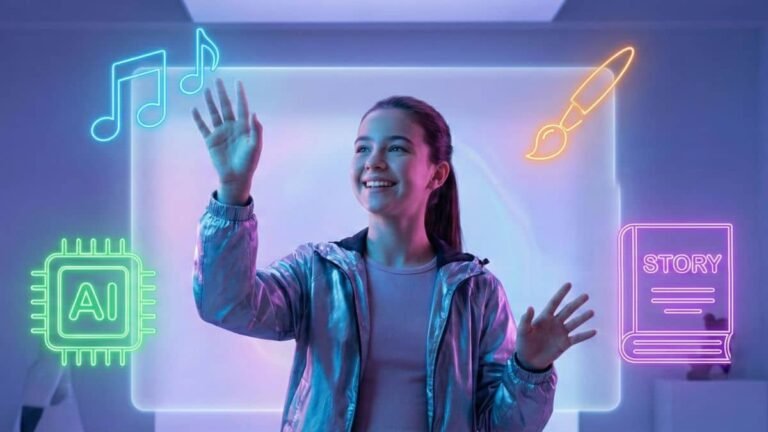Address
251 Little Falls Drive, Wilmington, DE 19808, United States

Think AI tools are just for adults? Think again. In 2025, a wave of innovative AI learning tools is transforming how children absorb knowledge, turning homework into something they actually enjoy, especially when matched to the right age and stage of learning. These tool don’t just teach; they adapt, respond, and grow with your child. If you want smarter, safer, and more engaging learning, you’re in the right place. Let’s dive into the best AI tools for kids today.
Table of Contents
Why AI learning tools are revolutionizing childhood education
In 2025, artificial intelligence is no longer just powering big tech, it’s transforming how kids learn, ask questions, and explore the world. AI learning tools are increasingly tailored to young minds, adapting in real-time to each child’s pace, interests, and skill level. This personalized experience not only boosts engagement but also builds confidence in ways traditional classrooms sometimes can’t.
From voice-driven tutors to gamified quiz generators, today’s tools are more interactive, vibrant, and responsive than ever before. They offer bite-sized lessons, real-time feedback, and creative thinking challenges, all through a screen that feels more like play than study. The best part? Many of these tools are designed to grow with your child, evolving from simple language lessons to complex problem-solving environments as they mature.
If you’re wondering how AI learning for kids fits into a healthy education journey, you’re not alone. Let’s look at some of the most innovative tools parents and educators are turning to right now.
5 Kid-friendly AI apps that make learning fun (like Brainly & Quillionz)
Brainly: Peer-powered homework help
Brainly uses AI to filter quality answers and match questions to the best student contributors. It’s like having a smart study buddy available 24/7. Kids post homework questions, and Brainly’s community, guided by machine learning, offers reliable explanations. The app helps kids think through problems instead of just copying answers, and parents love the transparency of the feedback system.
Quillionz: Smart quiz & question generation
Need quick revision material? Quillionz is a clever AI platform that helps kids (and teachers) generate multiple-choice quizzes or short-answer questions based on any content they paste in. It’s perfect for reviewing school notes or preparing for tests in a more interactive, student-led way. The tool encourages comprehension rather than memorization: a critical shift in modern learning.
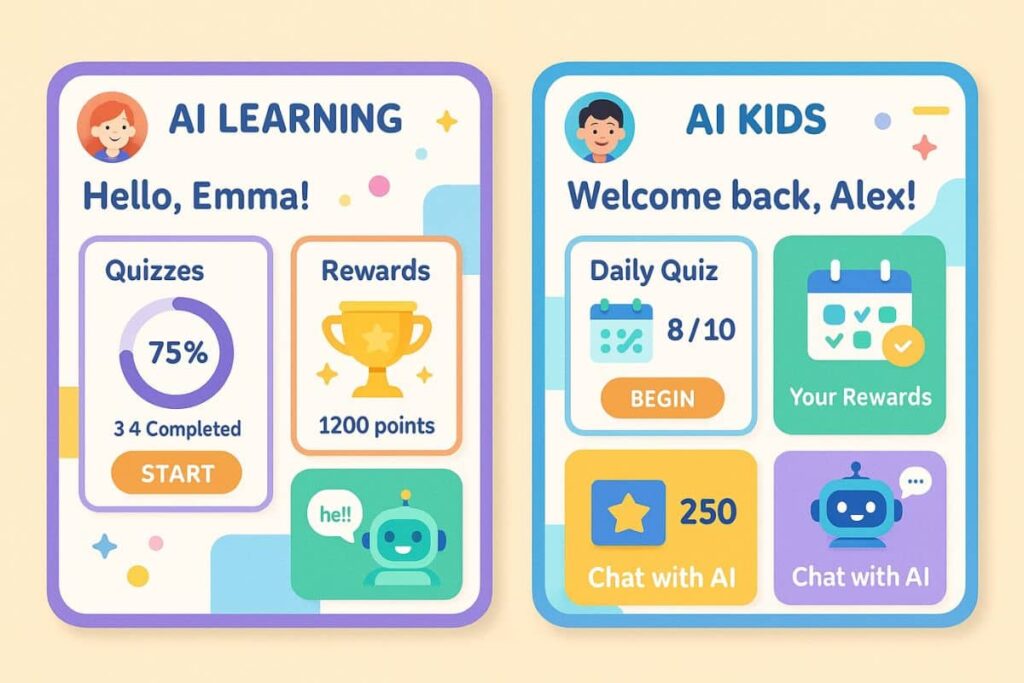
Socratic by Google: Visual learning for all ages
Socratic is a free app by Google that uses AI and image recognition to break down homework questions into easy-to-follow visual guides. Snap a photo of a math problem or science question, and Socratic returns intuitive explanations, graphs, and related concepts. It’s like having a teacher in your pocket: great for visual learners and curious minds.
Duolingo: Language learning that feels like play
While many know Duolingo for its catchy owl mascot, the AI behind the app is what keeps kids coming back. The platform adapts in real-time to language proficiency, focusing more on weaker areas and repeating key terms when needed. With reward systems, streak tracking, and short lessons, it gamifies language learning without overwhelming younger users.
Khan Academy Kids: AI-enhanced early learning
Built specifically for preschool and early elementary learners, Khan Academy Kids uses AI to guide children through a mix of stories, games, and exercises. It adjusts lesson difficulty on the fly, based on your child’s performance and interactions. The app also includes emotional learning prompts, teaching kids empathy alongside math and reading.
For more platforms like this, explore our full guide on AI learning apps for young minds.
Why AI engagement matters more than traditional worksheets
Let’s face it: traditional worksheets often fail to keep kids truly engaged. They’re linear, repetitive, and offer no real-time feedback. In contrast, AI learning tools adjust instantly to a child’s responses. Got a question wrong? The app shifts the lesson, offers a hint, or rephrases the content. This adaptive approach doesn’t just teach, it coaches.
AI engagement taps into a child’s natural sense of curiosity. Games, progress bars, sound cues, and interactive visuals all combine to make lessons feel like an adventure. This matters more than ever, especially for digital-native kids who are used to instant responsiveness in everything they touch, from video games to voice assistants. When kids feel like the learning experience is “alive,” they’re more likely to stay focused, try again after mistakes, and take ownership of their progress.
That’s something a stack of printed worksheets just can’t compete with and why AI tools are quickly replacing them in both classrooms and homes.
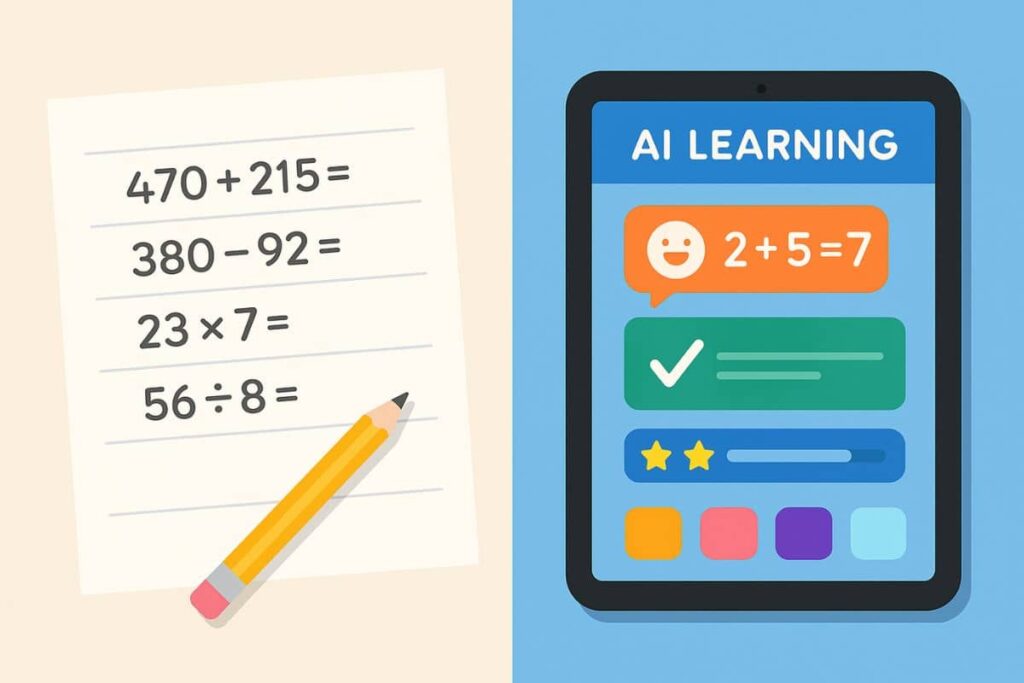
How to choose the right AI tool based on age
AI tools for ages 4–7: Play-based and visual apps
Younger children benefit most from tools that offer vibrant visuals, engaging audio, and simple instructions. Look for apps that focus on recognition, storytelling, or basic math and language skills. At this stage, the AI’s role is to introduce concepts gently and repeat them in fun, memorable ways. Tools like Khan Academy Kids and ABCmouse are great examples of age-appropriate, play-driven platforms with adaptive learning paths.
AI tools for ages 8–12: Interactive and adaptive learning
As kids move into middle childhood, they’re ready for more structured, goal-oriented learning. AI tools like Quillionz and Duolingo help kids take ownership of their education by offering instant feedback and a sense of progression. These platforms can identify where a child is struggling and provide targeted practice, all while keeping the experience fun through challenges, gamification, and social learning.
AI tools for teens: Advanced skills and creative projects
Teenagers often crave autonomy, and the best AI tools give them exactly that. Platforms like Tynker or Google’s Teachable Machine let teens explore programming, machine learning, and even build their own AI models. These tools provide real-world skills in a hands-on format, encouraging experimentation and creativity. For academic support, tools like Brainly and Socratic are ideal for high school homework and test prep.
Exploring AI for self-reflection and deeper thinking
For teens seeking more than just academic support, AI tools like Replika introduce a new category of learning: emotional intelligence and self-awareness. While not designed specifically for education, these AI companions allow teens to explore reflective thinking, roleplay social scenarios, and even practice foreign languages in a natural chat interface.
Other platforms are exploring “Socratic-style” discussions, where AI engages teens in ethical debates or philosophical questions. These tools sharpen reasoning skills and open up new ways to think critically, preparing students not just for exams, but for life.
Parental guide to AI: Safe use & screen time tips
Setting boundaries and healthy screen time habits
Even with the most educational apps, moderation is key. Experts recommend no more than 1 hour of screen time per day for kids under 6, and balanced schedules for older children. Use AI tools as part of a routine: for example, 20 minutes of AI-assisted learning followed by hands-on activities like drawing or outdoor play. For more tips on responsible use, see our parental guide to AI safety.
Privacy and data concerns: What parents should know
Always review the privacy policies of AI apps. Check whether they collect personal data, use it for training purposes, or share it with third parties. Stick to platforms that offer parental dashboards, ad-free experiences, and data encryption. Trusted names like Khan Academy and Duolingo prioritize child safety and keep their platforms COPPA-compliant (Children’s Online Privacy Protection Act).
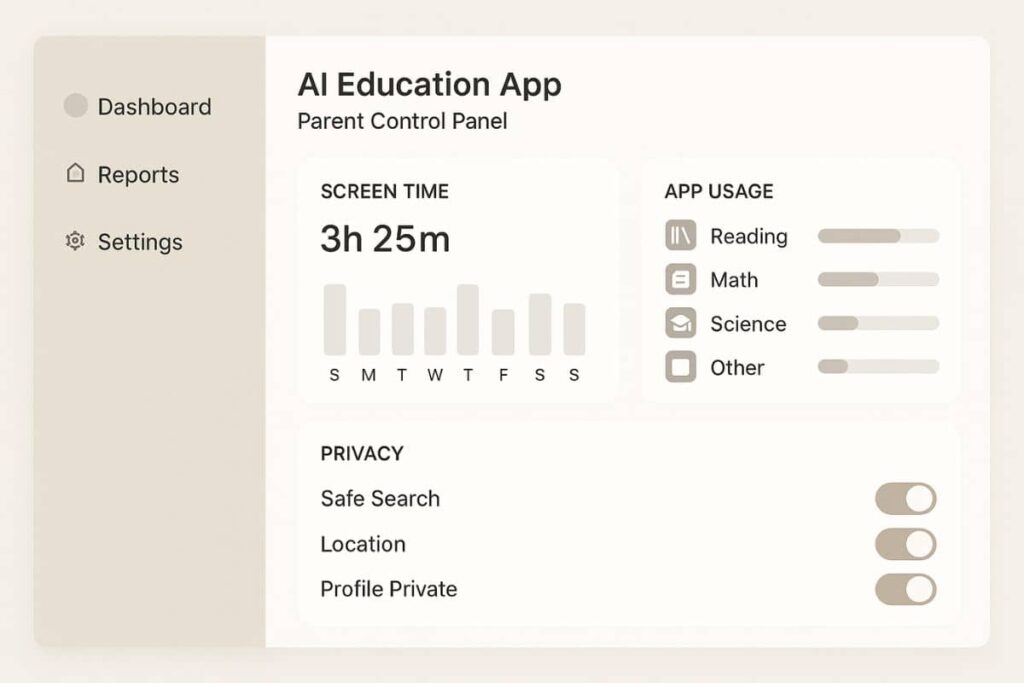
Encouraging balanced use: Offline and online integration
The most effective way to integrate AI into your child’s education is to connect the lessons learned online to real-life experiences. For example, after a language lesson, encourage your child to speak those words at dinner. After solving math puzzles in an app, try baking together and measuring ingredients. Blending AI with the physical world keeps learning holistic and meaningful. For more practical tips, explore our parent’s survival guide to ChatGPT for homework help.
Real-life stories: How kids are benefiting from AI today
Case study: 10-Year-old learns math faster using AI tutor
Meet Jacob, a 10-year-old who used to struggle with long division. His parents introduced him to an AI-powered tutoring app that adapted each lesson based on his speed and accuracy. Within three weeks, Jacob not only caught up with his classmates but surpassed them in mental math. The app celebrated his small wins and gave visual hints when he got stuck, turning frustration into motivation.
Classroom impact: Teachers using AI to personalize lessons
In a 5th grade classroom in Chicago, teachers have started integrating AI tools to identify learning gaps in real time. One platform flagged a pattern showing that multiple students misunderstood a geometry concept. The teacher quickly reviewed the lesson using interactive AI visuals, and the class saw a 30% improvement in test scores the following week. The AI didn’t replace the teacher, it empowered them.
What’s next? The future of AI learning tools for children
AI-powered emotional intelligence & mental health support
The next wave of AI tools isn’t just about knowledge. Emerging platforms are now exploring how to respond to a child’s tone of voice, facial expressions, or writing patterns to detect emotional states. Imagine an app that pauses a math challenge if a child seems frustrated and instead offers encouragement or a mindfulness break. These emotionally aware systems could help address mental health challenges before they escalate.
Global accessibility: AI tools for kids in remote or underserved regions
One of the most exciting frontiers for AI learning tools is their ability to reach children in underserved or remote regions. Thanks to cloud computing and low-bandwidth versions, many AI apps now work even on basic smartphones or offline in downloadable modes. These tools are being used in parts of Africa, Southeast Asia, and Latin America to deliver math, science, and literacy education where traditional resources are scarce.
What’s more, multilingual AI models are helping children learn in their native languages or bridge gaps to global ones like English and Spanish. This democratization of learning isn’t just revolutionary, it’s equitable. As infrastructure improves and tech becomes more affordable, AI may soon become the most powerful force for educational inclusion the world has ever seen.
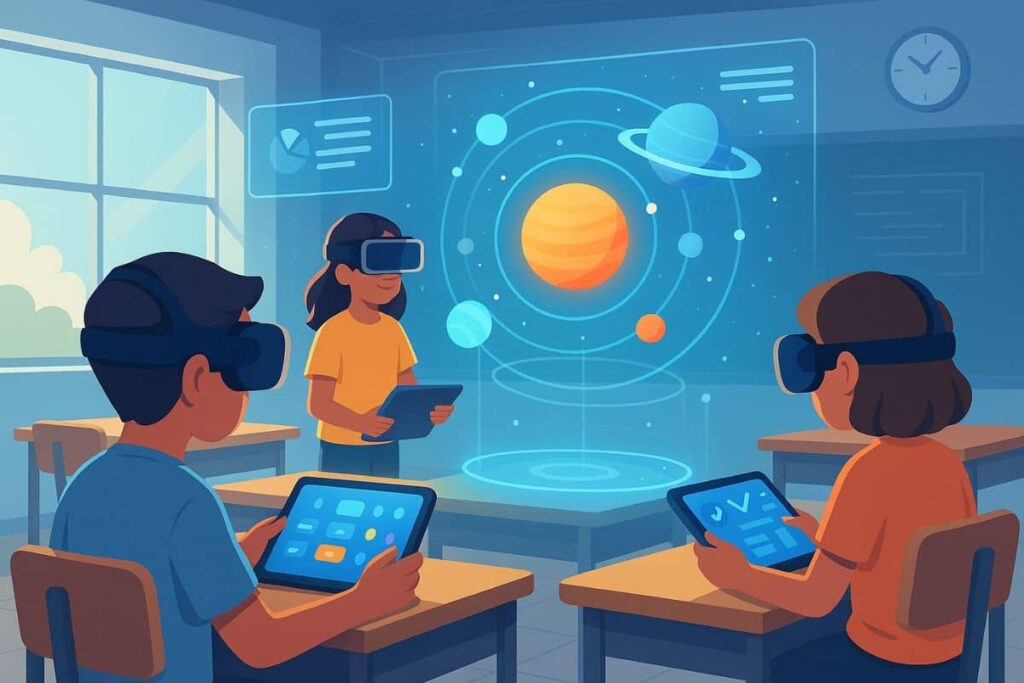
Voice + AR integration: Where learning gets even smarter
Artificial intelligence is converging with other exciting technologies like Augmented Reality (AR) and voice recognition. Children will soon interact with virtual environments using natural language, solving puzzles, building stories, or exploring ancient worlds as if they were physically there. These immersive tools will make subjects like history, science, and art more vivid and memorable than ever before.
With the right balance of guidance and exploration, AI learning for kids can unlock creativity, curiosity, and a lifelong love of discovery. 2025 is shaping up to be a thrilling chapter in how we empower young minds to learn smarter and love it.
AI learning tools are no longer a futuristic concept, they’re an essential part of modern childhood education. Whether your child is just starting school or exploring complex projects, there’s an AI platform to guide their journey. With thoughtful use and the right guidance, these tools can empower kids to become lifelong learners.




